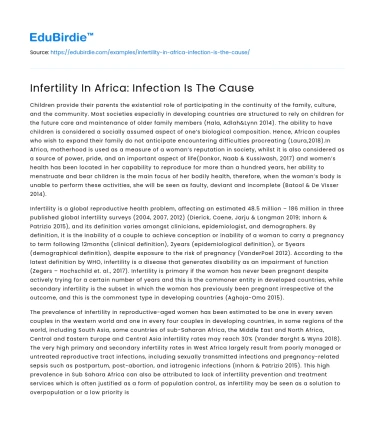Children provide their parents the existential role of participating in the continuity of the family, culture, and the community. Most societies especially in developing countries are structured to rely on children for the future care and maintenance of older family members (Hala, Adlah&Lynn 2014). The ability to have children is considered a socially assumed aspect of one’s biological composition. Hence, African couples who wish to expand their family do not anticipate encountering difficulties procreating (Laura,2018).In Africa, motherhood is used as a measure of a woman’s reputation in society, whilst it is also considered as a source of power, pride, and an important aspect of life(Donkor, Naab & Kussiwash, 2017) and women’s health has been located in her capability to reproduce for more than a hundred years, her ability to menstruate and bear children is the main focus of her bodily health, therefore, when the woman’s body is unable to perform these activities, she will be seen as faulty, deviant and incomplete (Batool & De Visser 2014).
Infertility is a global reproductive health problem, affecting an estimated 48.5 million – 186 million in three published global infertility surveys (2004, 2007, 2012) (Dierick, Coene, Jarju & Longman 2019; Inhorn & Patrizio 2015), and its definition varies amongst clinicians, epidemiologist, and demographers. By definition, it is the inability of a couple to achieve conception or inability of a woman to carry a pregnancy to term following 12months (clinical definition), 2years (epidemiological definition), or 5years (demographical definition), despite exposure to the risk of pregnancy (VanderPoel 2012). According to the latest definition by WHO, infertility is a disease that generates disability as an impairment of function (Zegers – Hochschild et. al., 2017). Infertility is primary if the woman has never been pregnant despite actively trying for a certain number of years and this is the commoner entity in developed countries, while secondary infertility is the subset in which the woman has previously been pregnant irrespective of the outcome, and this is the commonest type in developing countries (Aghoja-Omo 2015).
Save your time!
We can take care of your essay
- Proper editing and formatting
- Free revision, title page, and bibliography
- Flexible prices and money-back guarantee
The prevalence of infertility in reproductive-aged women has been estimated to be one in every seven couples in the western world and one in every four couples in developing countries, in some regions of the world, including South Asia, some countries of sub-Saharan Africa, the Middle East and North Africa, Central and Eastern Europe and Central Asia infertility rates may reach 30% (Vander Borght & Wyns 2018). The very high primary and secondary infertility rates in West Africa largely result from poorly managed or untreated reproductive tract infections, including sexually transmitted infections and pregnancy-related sepsis such as postpartum, post-abortion, and iatrogenic infections (Inhorn & Patrizio 2015). This high prevalence in Sub Sahara Africa can also be attributed to lack of infertility prevention and treatment services which is often justified as a form of population control, as infertility may be seen as a solution to overpopulation or a low priority issue by the policymakers in the context of scarce health care resources, poor medical infrastructure, and the heavy burden of other life-threatening problems such as HIV/AIDS (acquired immune deficiency syndrome), malaria and maternal mortality (Inhorn & Patrizio 2015; Mascarenhas et al 2012). In Nigeria, one in five (or even a third) of couples suffer the ill effect of infertility with the rate as high as 20-45% (Aghoja-Omo. 2015). It has been described as the most important reproductive health concern of Nigerian women and accounts for between 60% and 70% of gynecological consultations in tertiary health institutions (Omoaregbe, James, Lawani, Morakinjo & Olotu, 2013).






 Stuck on your essay?
Stuck on your essay?

